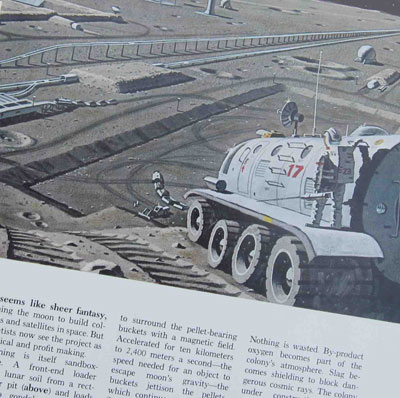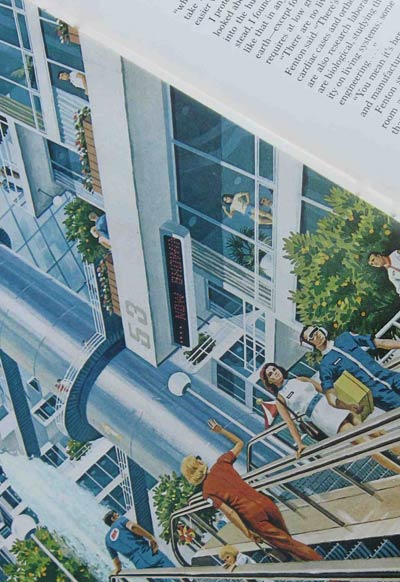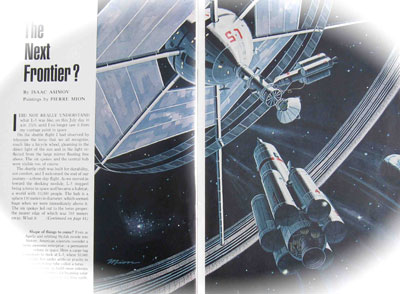The god that failedby Dwayne Day
|
| My suspicion is that the first exposure many Americans had to the concept of colonies in space came in the summer of 1976 when the July issue of National Geographic showed up in their mailboxes. |
Asimov’s article, “The Next Frontier?” and illustrated by Pierre Mion, was written as a first-person account of a visit to an L-5 colony in the far-distant future of 2026. The account is mostly description: the National Geographic reporter is met by the colony’s director George Fenton, who shows him around and explains how everything works. Asimov experiences the gradual onset of simulated gravity as he travels from the arrival hub down a spoke to the colony’s rim. The colony is nearly 1,800 meters in diameter and houses 10,000 people.
Fenton shows him the farms and the industrial areas. He introduces the reporter to a rabbit meat hot dog and goat milk shake. He explains how the population is majority male, but they do have women, and families, and even a thousand children on the station. He shows the reporter a residential area and explains that the streets curve back and forth so that you cannot see them end and become disoriented. Fenton explains how the six segments of the torus are separated by airlocks in case of emergency. The colony is not completely self-contained but is working on it. They still import things from Earth, but most of their raw materials come from the Moon. And of course they recycle everything that they can; the reporter declines Fenton’s offer to tour the sewage plant.
Then of course there is the explanation of how all of this is possible. The manufacturing of solar power stations to supply Earth is a major economic driver, but “old news” according to Fenton. Instead, their newest industry is the growing of crystals and the manufacture of microcomputer circuitry. But, Fenton adds, for a long time to come the primary activity of the colonists will be building other colonies. Asimov adds that it will be a long time, if ever, before the population of the colonies exceeds the population of Earth.
Although Asimov’s future reporter never made it to the manufacturing center, or the lunar mining facility, Mion’s paintings depicted them as well as the construction of the colony itself. Of course the lunar mining facility came equipped with a linear accelerator that fires the collected material up to a manufacturing station. The mining is described in a caption as “sandbox simple” and the regolith is scooped up from open-face pits and sent on its way.
Lest anyone think that this article was “science fiction” (the editor placed that term in quotes, somewhat in the same way that you put a dead fish in a trash bag), a footnote declares that in only a month’s time NASA would publish a new report: “Space Colonization: A Design Study”. Clearly, space colonies were a probable part of America’s future.
 (credit: National Geographic) |
Yesterday’s tomorrows
One of the common knocks against science fiction stories is that they do a poor job of predicting the future—critics gloated that the year 2001 came and went and there were no spinning space stations, only terrorism and falling towers. Of course, the legitimate defense is that science fiction writers are not trying to predict the future, only tell a story. But in the case of Asimov’s National Geographic article, the famed author was trying to predict what looked—in that heady bicentennial year—to be a realistic possible future only a few decades away.
The July 1976 issue also included an article titled “Five Noted Thinkers Explore the Future”: interviews with experts, including Asimov, speculating about the turn of the century, only 25 years away. Their predictions were a mixed bag, but a common theme was a focus on the future of the city, which many of them thought was good at a time when American cities were in crisis. New York, after all, had nearly declared bankruptcy a year before. In his interview Asimov speculated that cities would either go down, or up. Weather might drive the creation of underground cities where climate could be perpetually controlled and inhabitants would never have to worry about pesky things like thunderstorms, snow, or beautiful spring days. Or the cities could go upward, with the creation of giant rotating colonies at L-5 points deep out in space. It was clear which alternative Asimov preferred.
 (credit: National Geographic) |
Future’s past
Although he never said it in his interview or the article, Asimov was writing about the ideas of an emerging American social movement. His article reflected the influences of people like Gerard K. O’Neill (who is not mentioned) and the then-exciting concept that normal people—construction workers, welders, farmers, rabbit-slaughterers—could soon live and work in space. Pierre Mion’s illustrations of the colony show a gleaming city street that looks much like a midwestern American city, where the dominant male fashion is the jumpsuit, and women still wear miniskirts and denim short-shorts.
Within a very short time after Asimov’s article, O’Neill would publish The High Frontier, the L-5 Society would gain more members, and the pro-space colonization idea would form into a genuine movement.
But then it died.
Looking back over three decades to a time when this movement was just forming the most glaring conclusion is that it never really caught on. It never transformed into a true mass movement with broad appeal, millions of members, elected representatives in the government, and a clear legislative, social and economic agenda. Why was that?
| Looking back over three decades to a time when this movement was just forming the most glaring conclusion is that it never really caught on. Why was that? |
Of course, many of the movement’s early members will blame NASA. O’Neill’s space colony vision depended upon cheap spaceflight heralded by the Space Shuttle, and we all know how that worked out. Certainly, once the shuttles proved to be cranky and expensive, a lot of the public enthusiasm for space colonization subsided. Some people stuck with it, and became bitter. Many simply gave up.
The space colonization movement was, at its most basic, a utopian movement. Like all utopian movements, it had a short-term appeal that was more emotional than logical, and depended upon people being susceptible to the vision that it promised. It didn’t make many converts.
There was a problem with that vision: it was not inherently positive and uplifting. There were certainly many negative visions at the time: Malthusian predictions of doom, and the ever-present fear of nuclear annihilation. But the problem with the space colonization movement was that, absent the counterpoint of fear, it had little inherent appeal. Asimov’s portrayal of the L-5 future demonstrated the problem: what was so great about living and working in space compared to living and working on the ground? Asimov didn’t have an answer to that. He never described the view from the colony, nor did he claim that the work and living conditions were better than on Earth. His description of the food was not exactly mouth-watering. Other than that, what he described was a job and a bed to sleep in. If you were an ordinary American reading the National Geographic in 1976, what was so great about that?
Of course, many of the most strident advocates of space colonization will claim that the reason to go is to establish a new society with new rules and liberties. But the economics of a colony naturally tend to require rather strict rules—the company or government that funds such an endeavor is not going to want surly employees who wear “Stick it to The Man” t-shirts and waste hot water. And if your goal is to throw off unwanted rules and regulations it is easier to achieve this by joining or leading a political movement—or simply moving to Alaska—than launching a million tons of payload into a hostile environment.
| The Future, it was wonderful, but now it survives largely in the pages of faded magazines. |
There is an old joke about a company that makes a new kind of dog food. It invests millions in advertising and getting its product in stores. But it doesn’t sell. Befuddled, the company president goes to a store and watches people buy other bags of dog food. He goes up to the store manager. “I don’t get it,” he says. “Our packaging is flashier than our competitors’ packaging. Our display is the biggest in the store. It’s the most attractive dog food there is. Why isn’t it selling?”
“The dogs don’t like it,” replies the manager.
At its best, the space colonization vision was sophisticated daydreaming, not a future that a large number of Americans wanted to make happen. The vision had its shot and never caught on, despite appearing in the pages of a highly reputable magazine and gaining the attention of political decision makers. Gravity, weightlessness, radiation, and economics may all have ultimately made this vision untenable, but its biggest problem was that people didn’t like it.
We are living in the future that National Geographic’s experts speculated about. The cities are all right. World War III is no longer looming overhead. But grand visions of space colonization no longer appear in popular media. They no longer gain attention on news programs or in the halls of Congress. The Future, it was wonderful, but now it survives largely in the pages of faded magazines.
